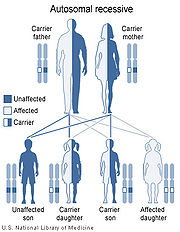
Recessive multiple epiphyseal dysplasia
Encyclopedia
Autosomal recessive multiple epiphyseal dysplasia (ARMED), also called epiphyseal dysplasia, multiple, 4 (EDM4), multiple epiphyseal dysplasia with clubfoot or –with bilayered patellae, is an autosomal
recessive congenital disorder
affecting cartilage
and bone
development. The disorder has relatively mild signs and symptoms, including joint pain, scoliosis
, and malformations of the hands, feet, and knees.
Some affected individuals are born with an inward- and downward-turning foot (a clubfoot). An abnormality of the kneecap called a double-layered patella is also relatively common. Although some people with recessive multiple epiphyseal dysplasia have short stature as adults, most are of normal height. The incidence is unknown as many cases are not diagnosed due to mild symptoms.

Mutations in the SLC26A2
(DTDST) gene, located at human chromosome
5q32-33.1
, are the cause of ARMED. It is considered a milder disorder within a spectrum of skeletal disorders caused by mutations in the gene, which encodes a protein that is essential for the normal development of cartilage and its conversion to bone. Mutations in the SLC26A2 gene alter the structure of developing cartilage, preventing bones from forming properly and resulting in associated skeletal maldevelopment.
The disorder is inherited in an autosomal recessive manner. This means the defective gene responsible for the disorder is located on an autosome
(chromosome 5 is an autosome), and two copies of the defective gene (one inherited from each parent) are required in order to be born with the disorder. The parents of an individual with an autosomal recessive disorder both carry
one copy of the defective gene, but usually do not experience any signs or symptoms of the disorder.
Autosome
An autosome is a chromosome that is not a sex chromosome, or allosome; that is to say, there is an equal number of copies of the chromosome in males and females. For example, in humans, there are 22 pairs of autosomes. In addition to autosomes, there are sex chromosomes, to be specific: X and Y...
recessive congenital disorder
Congenital disorder
A congenital disorder, or congenital disease, is a condition existing at birth and often before birth, or that develops during the first month of life , regardless of causation...
affecting cartilage
Cartilage
Cartilage is a flexible connective tissue found in many areas in the bodies of humans and other animals, including the joints between bones, the rib cage, the ear, the nose, the elbow, the knee, the ankle, the bronchial tubes and the intervertebral discs...
and bone
Bone
Bones are rigid organs that constitute part of the endoskeleton of vertebrates. They support, and protect the various organs of the body, produce red and white blood cells and store minerals. Bone tissue is a type of dense connective tissue...
development. The disorder has relatively mild signs and symptoms, including joint pain, scoliosis
Scoliosis
Scoliosis is a medical condition in which a person's spine is curved from side to side. Although it is a complex three-dimensional deformity, on an X-ray, viewed from the rear, the spine of an individual with scoliosis may look more like an "S" or a "C" than a straight line...
, and malformations of the hands, feet, and knees.
Some affected individuals are born with an inward- and downward-turning foot (a clubfoot). An abnormality of the kneecap called a double-layered patella is also relatively common. Although some people with recessive multiple epiphyseal dysplasia have short stature as adults, most are of normal height. The incidence is unknown as many cases are not diagnosed due to mild symptoms.
Cause and Genetics

Mutations in the SLC26A2
SLC26A2
The SLC26A2 protein is a member of the solute carrier family. In humans, this transporter is encoded by the SLC26A2 gene.- Function :The diastrophic dysplasia sulfate transporter is a transmembrane glycoprotein implicated in the pathogenesis of several human chondrodysplasias...
(DTDST) gene, located at human chromosome
Chromosome
A chromosome is an organized structure of DNA and protein found in cells. It is a single piece of coiled DNA containing many genes, regulatory elements and other nucleotide sequences. Chromosomes also contain DNA-bound proteins, which serve to package the DNA and control its functions.Chromosomes...
5q32-33.1
Chromosome 5 (human)
Chromosome 5 is one of the 23 pairs of chromosomes in humans. People normally have two copies of this chromosome. Chromosome 5 spans about 181 million base pairs and represents almost 6% of the total DNA in cells. Chromosome 5 is one of the largest human chromosomes, yet has one of the lowest gene...
, are the cause of ARMED. It is considered a milder disorder within a spectrum of skeletal disorders caused by mutations in the gene, which encodes a protein that is essential for the normal development of cartilage and its conversion to bone. Mutations in the SLC26A2 gene alter the structure of developing cartilage, preventing bones from forming properly and resulting in associated skeletal maldevelopment.
The disorder is inherited in an autosomal recessive manner. This means the defective gene responsible for the disorder is located on an autosome
Autosome
An autosome is a chromosome that is not a sex chromosome, or allosome; that is to say, there is an equal number of copies of the chromosome in males and females. For example, in humans, there are 22 pairs of autosomes. In addition to autosomes, there are sex chromosomes, to be specific: X and Y...
(chromosome 5 is an autosome), and two copies of the defective gene (one inherited from each parent) are required in order to be born with the disorder. The parents of an individual with an autosomal recessive disorder both carry
Genetic carrier
A genetic carrier , is a person or other organism that has inherited a genetic trait or mutation, but who does not display that trait or show symptoms of the disease. They are, however, able to pass the gene onto their offspring, who may then express the gene...
one copy of the defective gene, but usually do not experience any signs or symptoms of the disorder.

